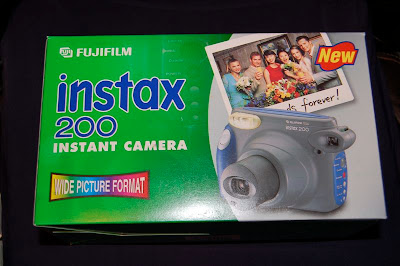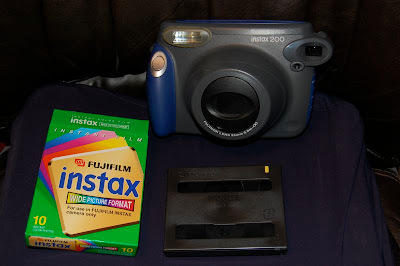
Fuji makes several kinds of Instax cameras and films (the mini format actually works in the old Polaroid Mio cameras - but alas, I don't have a Mio). I decided to make my first step with the Fuji Instax 200 camera and the Fuji Instax Wide Instant Film because the size/shape is pretty close to 600 and spectra. I actually dig the wide picture format - I think it will be pretty good for landscapes and cars. I look at a 24" widescreen iMac for hours, I watch widescreen movies, so it makes sense to shoot in a wide format too. The image rectangle is exactly 4" in width and almost 2.5" in height. The full size of the shot is a little over 4x3. The actual photos look exactly like what you'd expect to see from a Polaroid camera just in a different size/shape. I'm actually pleasantly surprised by the color rendition - it's pretty vivid - maybe even a little more than a Polaroid. The sucky thing for me is that there's no exact focusing like on my better Polaroid cameras (like my SX-70 Alpha and SLR 680 SE), nope, this is just like any of the run of the mill cheapie Polaroids where you have to pay attention to feet - or in the case of the Instax, freakin' meters! There's a button that changes the lens focus from .9-3 meters to 3 meters to infinity. I've taken a few out of focus shots at the .9-3 stage, so I guess I'm standing less than .9 meters and didn't realize - silly me - I guess I need to bring out a measuring tape to make sure! The whole meters thing throws me off, so today I actually converted the numbers and printed out a little label to put next to the numbers to recall the conversions. .9 = 2.9 feet and 3 = 9.8 feet.
The Fuji Instax cameras aren't normally sold in the U.S., but Mel Pierce camera in Hollywood has them on back order and carries the wide film. Most people get the film and cameras on ebay. There's also some Canadian online resellers that have them. I bought mine from Lomography.com - they specialize in all kinds of lo-fi cameras like Holgas and Dianas, cheap Russian plastic cameras and their own brand of Lomo cameras that have fisheye lenses, multiple lenses (actionsampler, colorspash). The Fuji Instax 200 plus 10 boxes of expired film (100 exposures) was $150 dollars plus 7 bucks shipping.
The Fuji Instax 200 looks like some insane, clunky toy camera.
 No one out in public has seen me shoot with it yet, but I suspect when they do, I will get some looks and probably questions. The flash can be turned on and off, but if the camera thinks the light is too low, it will put the flash on. This kind of sucks for taking shots of neon at night, but oh well. I guess I can stick some black gaffers tape on the flash if I'm desperate. I wish that the camera had a self timer shot because there's no way I can do a self portrait and be in focus - my arms length is not .9 meters!
No one out in public has seen me shoot with it yet, but I suspect when they do, I will get some looks and probably questions. The flash can be turned on and off, but if the camera thinks the light is too low, it will put the flash on. This kind of sucks for taking shots of neon at night, but oh well. I guess I can stick some black gaffers tape on the flash if I'm desperate. I wish that the camera had a self timer shot because there's no way I can do a self portrait and be in focus - my arms length is not .9 meters! 















All Fuji Instax photos by Lydia Marcus shot May 19, 2008 - May 21, 2009 in the San Fernando Valley






No comments:
Post a Comment